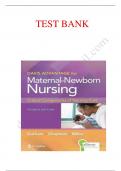TEST BANK
,Maternal-Newborn Nursing: The Critical Components Of Nursing Care, 4TH Edition,
RobertaDurham, Linda Chapman
Maternal-Newborn Nursing:
The Critical Components Of
Nursing Care 4TH Edition
Durham Chapman
,Maternal-Newborn Nursing: The Critical Components Of Nursing Care, 4TH Edition,
RobertaDurham, Linda Chapman
Chapter 1: Trends and Issues
MULTIPLE CHOICE
1. The nurse is caring for a patient who is in labor with her first child. The patient’s mother
is present for support and notes that things have changed in the delivery room since she last gave
birth in the early 1980s. Which current trend or intervention may the patient’s mother find most
different?
1. Fetal monitoring throughout labor
2. Postpartum stay of 10 days
3. Expectant partner and family in operating room for cesarean birth
4. Hospital support for breastfeeding
ANS: 4
Chapter: Chapter 1 Trends and Issues
Chapter Learning Objective: 1. Discuss current trends in the management of labor and birth
Page: 4
Heading: Table 1-1: Past and Present Trends Integrated Processes: Nursing Process
Client Need: Health Promotion and Maintenance Cognitive Level: Application [Applying]
Concept: Evidence-Based Practice
Difficulty: Moderate
Feedback
1 This is incorrect. Fetal monitoring during labor began in the late 1970s. As such,
this likely would have occurred during the mother’s labor and delivery during the 1980s.
, Maternal-Newborn Nursing: The Critical Components Of Nursing Care, 4TH Edition,
RobertaDurham, Linda Chapman
2 This is incorrect. In the past, the average hospital postpartum stay was 10 days.
Presently, the average postpartum stay is 48 hours or less.
3 This is incorrect. In the past, expectant partners and families were excluded from the
labor and birth experience. Present trends involve the expectant partner and family in the labor
and birth experience, including presence in the operating
room for cesarean births.
4 This is correct. Hospital support for breastfeeding, including a lactation consultant and
employment of the Baby-Friendly Hospital Initiative, were both
enacted during the early 1990s.
PTS: 1 CON: Evidence-Based Practice
2. A patient with a history of hypertension is giving birth. During delivery, the staff was not
able to stabilize the patient’s blood pressure. As a result, the patient died shortly after delivery.
This is an example of what type of death?
1. Early maternal death
2. Late maternal death
3. Direct obstetric death
4. Indirect obstetric death ANS: 4
Chapter: Chapter 1 Trends and Issues
Chapter Learning Objective: 2. Discuss current trends in maternal and infant health outcomes.
Page: 7
Heading: Trends > Maternal Death and Mortality Rates Integrated Processes: Nursing Process
Client Need: Physiological Integrity: Reduction of Risk Potential Cognitive Level: Application
[Applying]
Concept: Ante/Intra/Post-partum Difficulty: Hard




